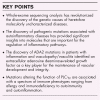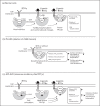When less is more: primary immunodeficiency with an autoinflammatory kick
- PMID: 25337682
- PMCID: PMC4212813
- DOI: 10.1097/ACI.0000000000000117
When less is more: primary immunodeficiency with an autoinflammatory kick
Abstract
Purpose of review: Next-generation sequencing is revolutionizing the molecular taxonomy of human disease. Recent studies of patients with unexplained autoinflammatory disorders reveal germline genetic mutations that target important regulators of innate immunity.
Recent findings: Whole-exome analyses of previously undiagnosed patients have catalyzed the recognition of two new disease genes. First, a phenotypic spectrum, including livedo racemosa, fever with early-onset stroke, polyarteritis nodosa, and Sneddon syndrome, is caused by loss-of-function mutations in cat eye syndrome chromosome region, candidate 1 (CECR1), encoding adenosine deaminase 2. Adenosine deaminase 2 is a secreted protein expressed primarily in myeloid cells, and a regulator of macrophage differentiation and endothelial development. Disease-associated mutations impair anti-inflammatory M2 macrophage differentiation. Second, patients presenting with cold-induced urticaria, granulomatous rash, autoantibodies, and common variable immunodeficiency, or with blistering skin lesions, bronchiolitis, enterocolitis, ocular inflammation, and mild immunodeficiency harbor distinct mutations in phospholipase Cγ₂, encoding a signaling molecule expressed in natural killer cells, mast cells, and B lymphocytes. These mutations inhibit the function of a phospholipase Cγ₂ autoinhibitory domain, causing increased or constitutive signaling.
Summary: These findings underscore the power of next-generation sequencing, demonstrating how the primary deficiency of key molecular regulators or even regulatory motifs may lead to autoinflammation, and suggesting a possible role for cat eye syndrome chromosome region, candidate 1 and phospholipase Cγ₂ in common diseases.
Figures



References
-
- International FMF Consortium. Ancient missense mutations in a new member of the RoRet gene family are likely to cause familial Mediterranean fever. Cell 1997; 90:797–807 - PubMed
-
- French FMF Consortium. A candidate gene for familial Mediterranean fever. Nat Genet 1997; 17:25–31 - PubMed
-
- McDermott MF, Aksentijevich I, Galon J, et al. Germline mutations in the extracellular domains of the 55 kDa TNF receptor, TNFR1, define a family of dominantly inherited autoinflammatory syndromes. Cell 1999; 97:133–144 - PubMed
Publication types
MeSH terms
Substances
Grants and funding
LinkOut - more resources
Full Text Sources
Other Literature Sources
Medical
Research Materials
Miscellaneous

